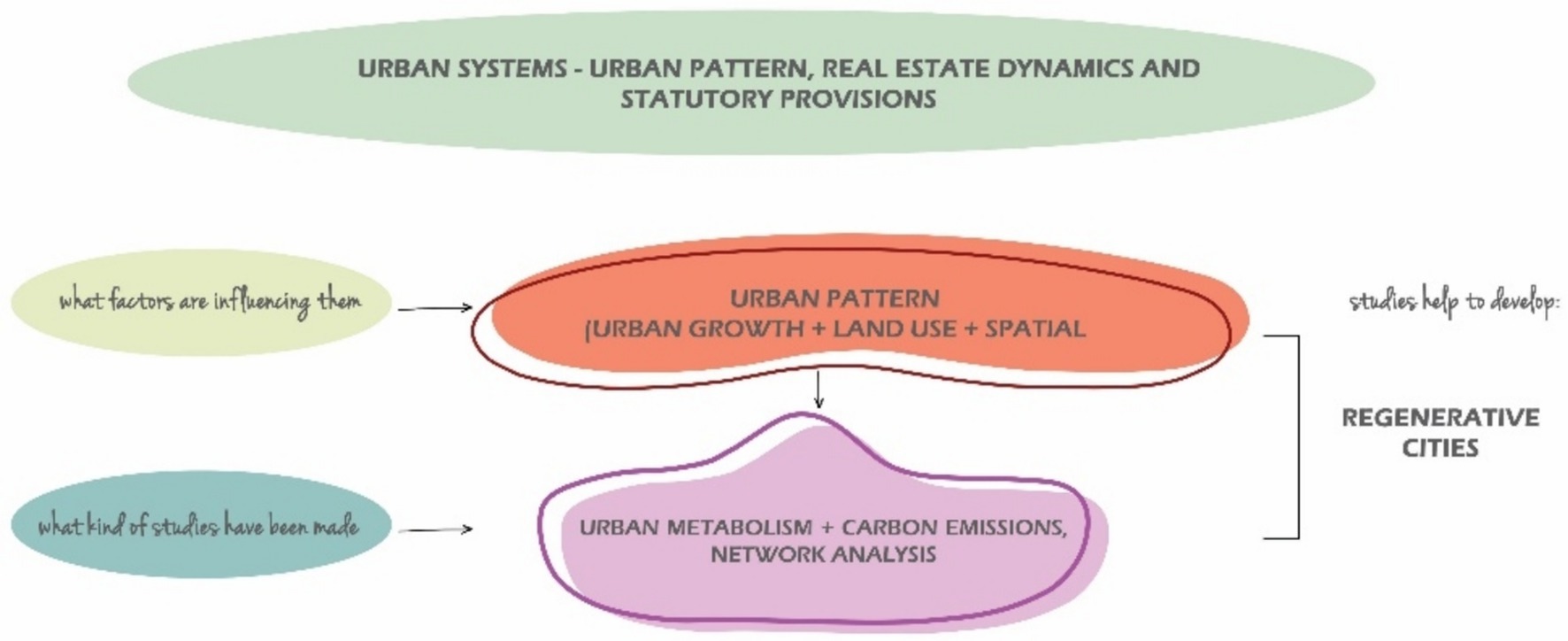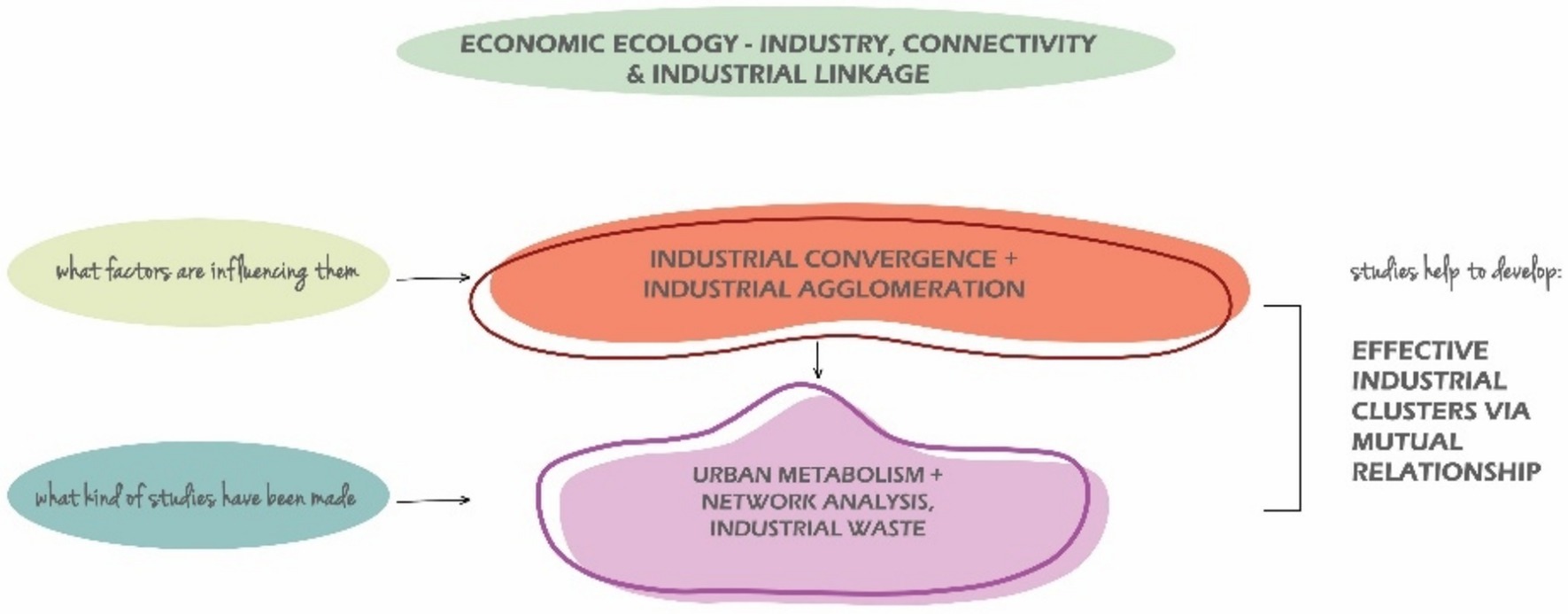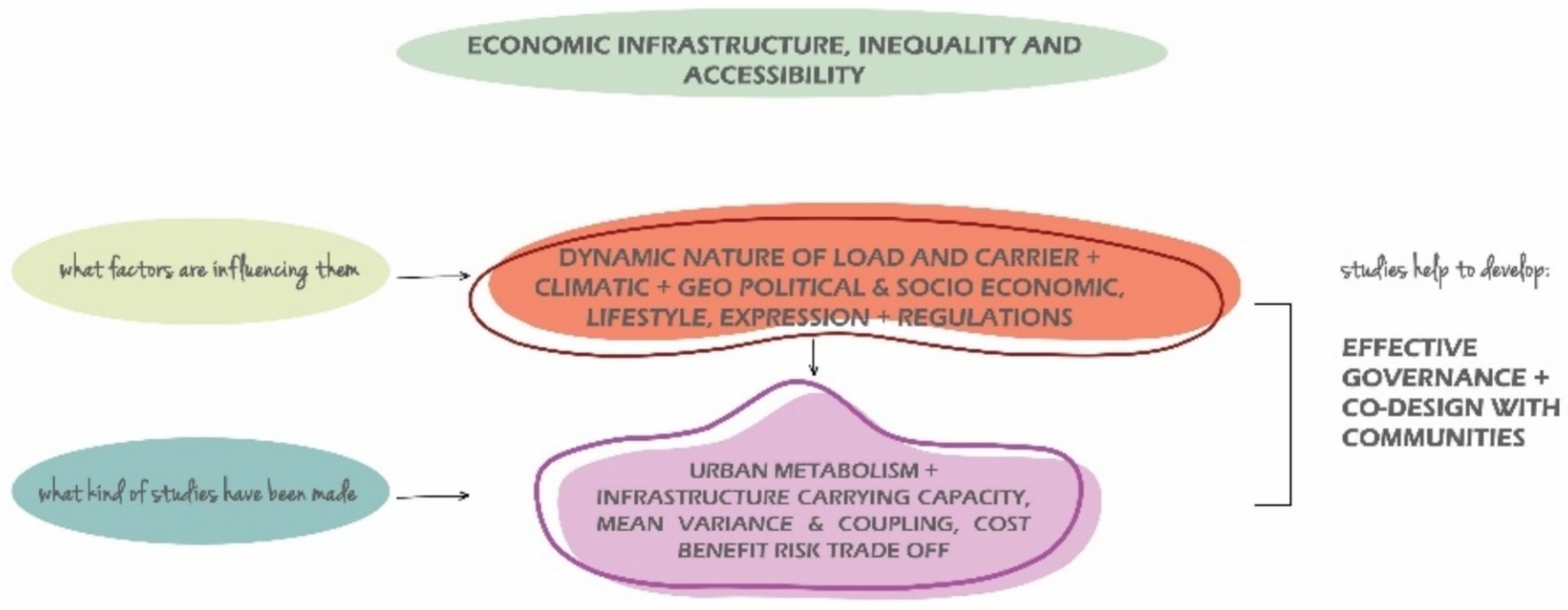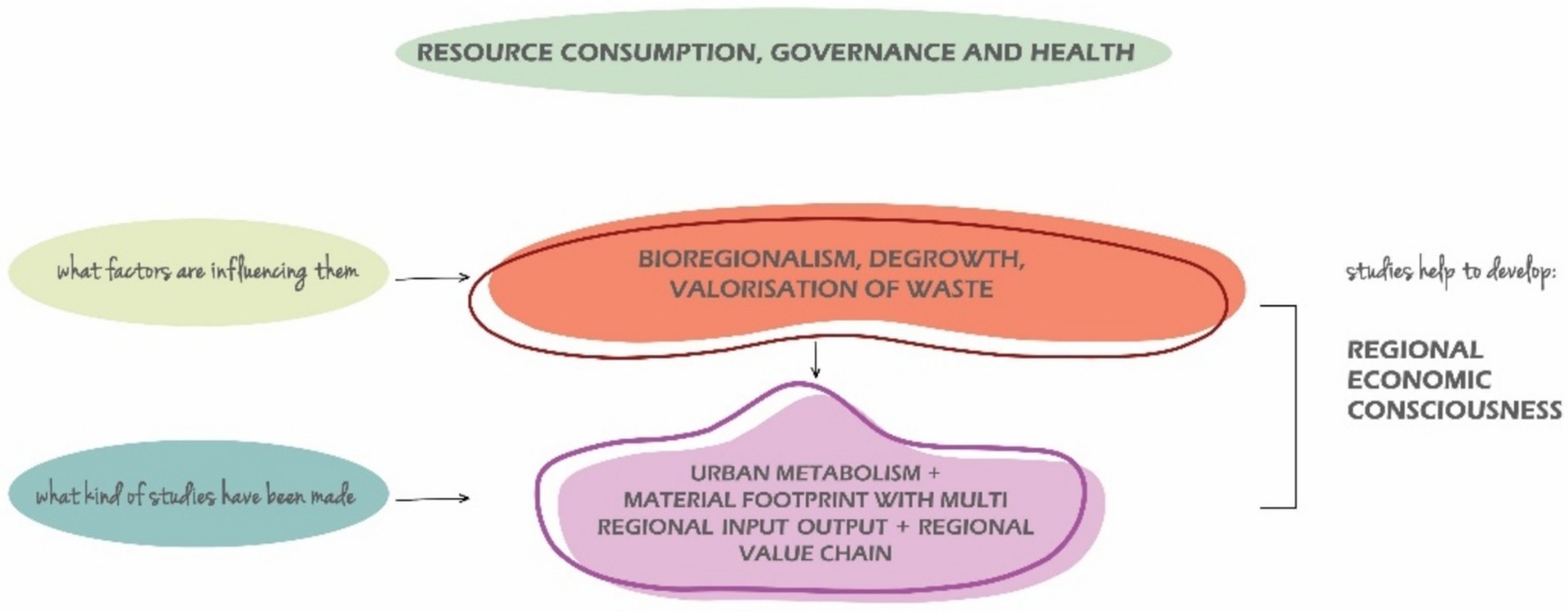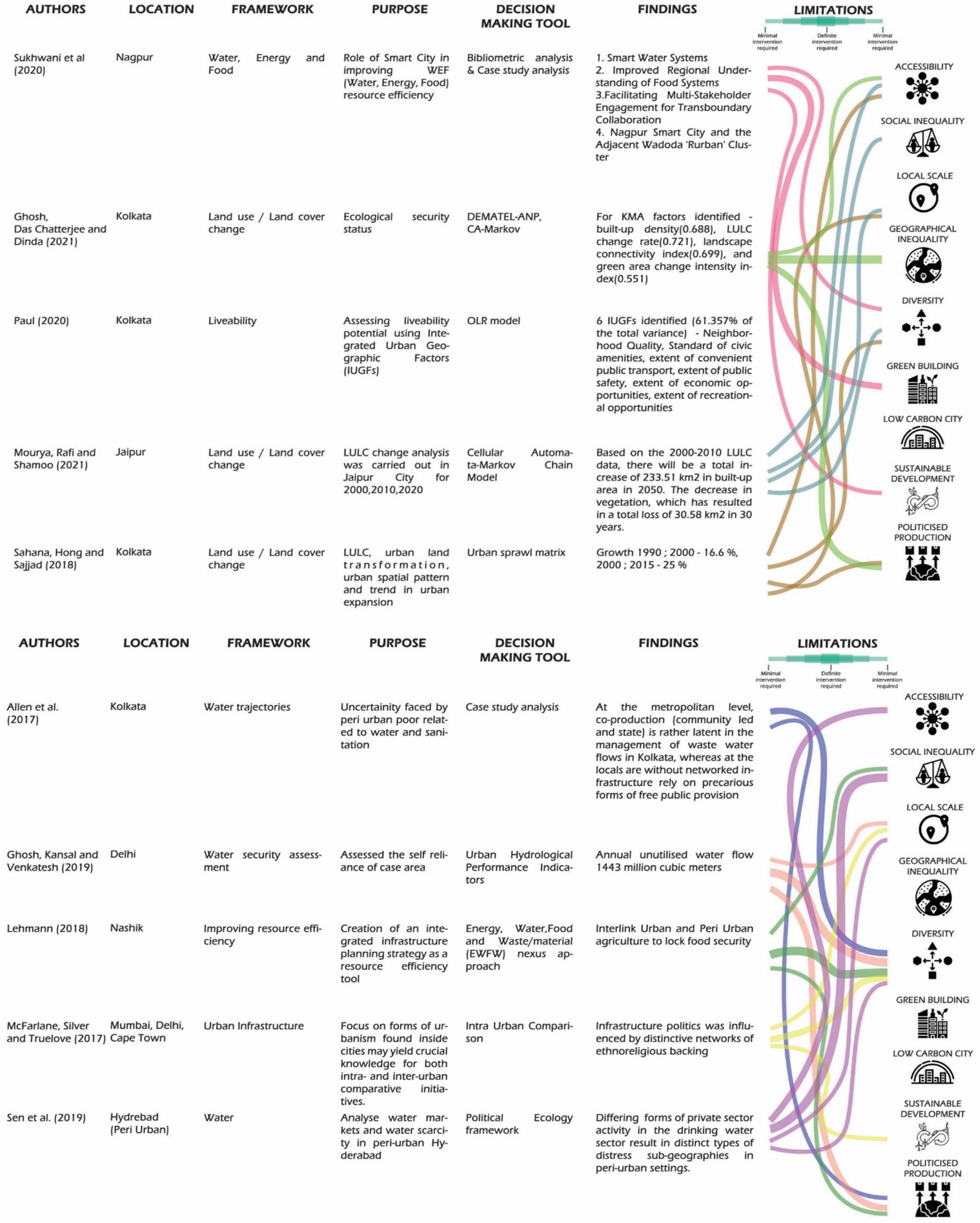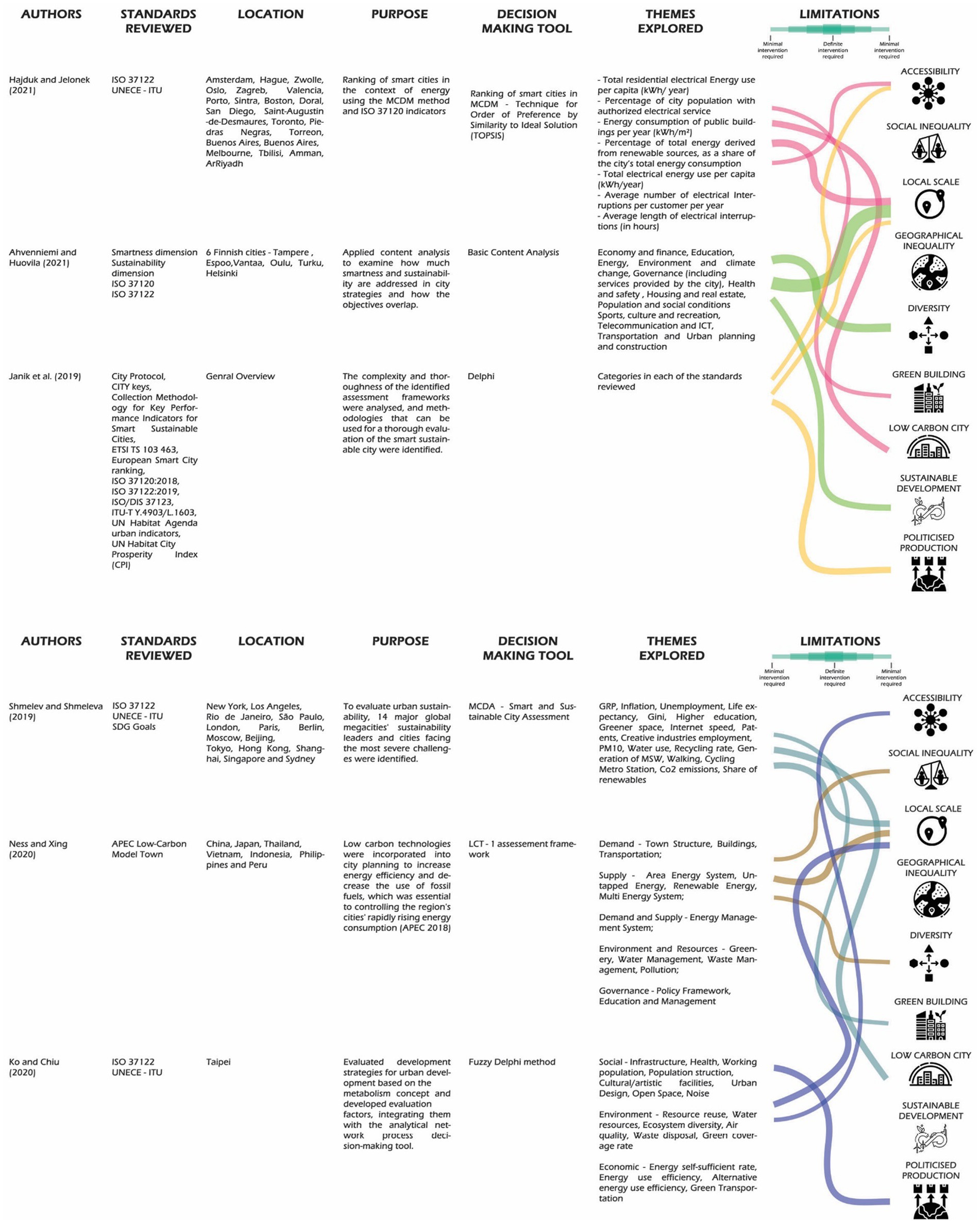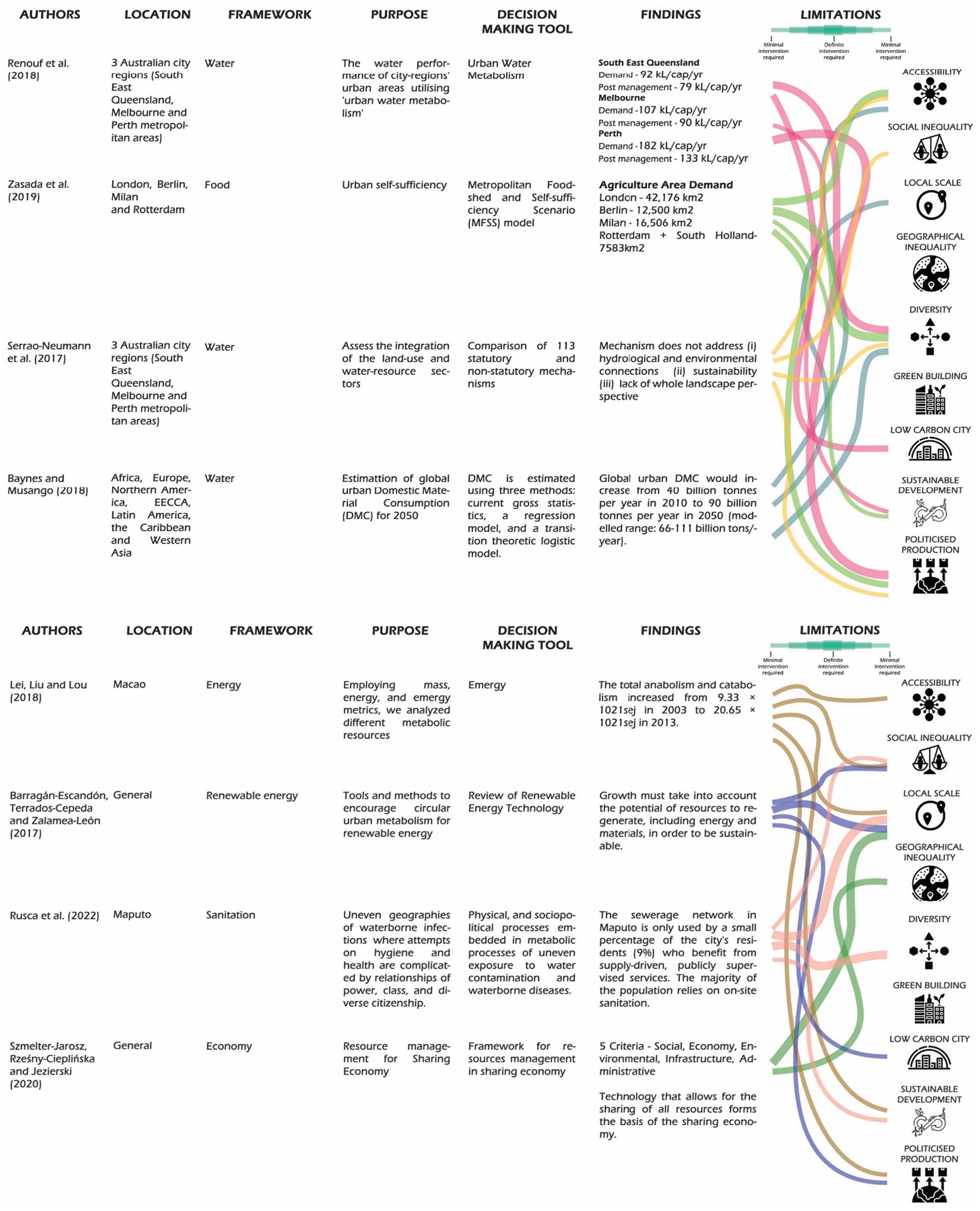- 1School of Architecture and Planning, Anna University, Chennai, Tamil Nadu, India
- 2Department of Civil Engineering, Anna University, Chennai, Tamil Nadu, India
Urban Metabolism is derived from a biological-based mechanism wherein a city is metaphorically analyzed from a biological perspective, which tracks the transformation of resources and addresses key questions related to self-sufficiency and consumer behavior. This research, for the first time, explores Urban Metabolism as a tool to evaluate sustainability-related framework and standards for urban regions on both global and local scales to address regional disparity and better means to devolve powers to local planning institutions. In the first half of the study, an adaptive approach was used to categorize the concept and find its connection with SDGs, wherein it was inferred that a new section under economic ecology has evolved, which requires policy interventions as its application at regional context creates lacunae in terms of UPE (Urban Political Economy). Furthermore, the study explores case studies and identifies the characteristics of urban metabolic systems to comprehend the trend in the idea and the necessity of using the UM lens at two different scales with two different narratives to solve entirely different challenges under the same component. The second part of the article looks at how the concept is used within current research. The results of the “perspective methods” were compared to gathered standard guidelines, and their shortcomings were noted to help close the implementation gap between researchers and practitioners. This suggests that policies, frameworks, guidelines, and other documents should adopt the discussed integrated approach to devolve power to local planning areas.
1 Introduction
Cities are hubs for socioeconomic activities and wealth accumulation, accounting for 55% of the global population. The ongoing trend of haphazard urbanization has led to various problems related to climate change, such as increased Greenhouse Gas (GHG) emissions, drought, loss of species, health risks, poverty, etc. By 2050, the urban population is expected to increase to 68% of the global population (United Nations Environment Programme, 2020). Some of the scientific findings by the International Resource Panel on the impact of urbanization include the following: (a) increased resource mining, production and processing that has resulted in a 90% loss in biodiversity and water stress and 50% of GHG emissions; and (b) the material footprint of consumption per capita of developed nations is 60% higher than that of developing nations and 13 times that of underdeveloped nations (C40 Cities, 2019). Besides, the IPCC (International Panel on Climate Change) in 2018 released its ‘Special Report on Global Warming of 1.5°C’ and revealed that an increase of 1.5°C leads to a comparatively congenial global living condition of the ecosystem (IPCC, 2022). Instead of 2°C, limiting global warming to 1.5°C might prevent 420 million people from regularly experiencing extreme heat and 65 million from experiencing exceptional heat. This reflects that biodiversity loss and resource stresses greatly depend on economic-based urbanization on a global level (Figure 1).
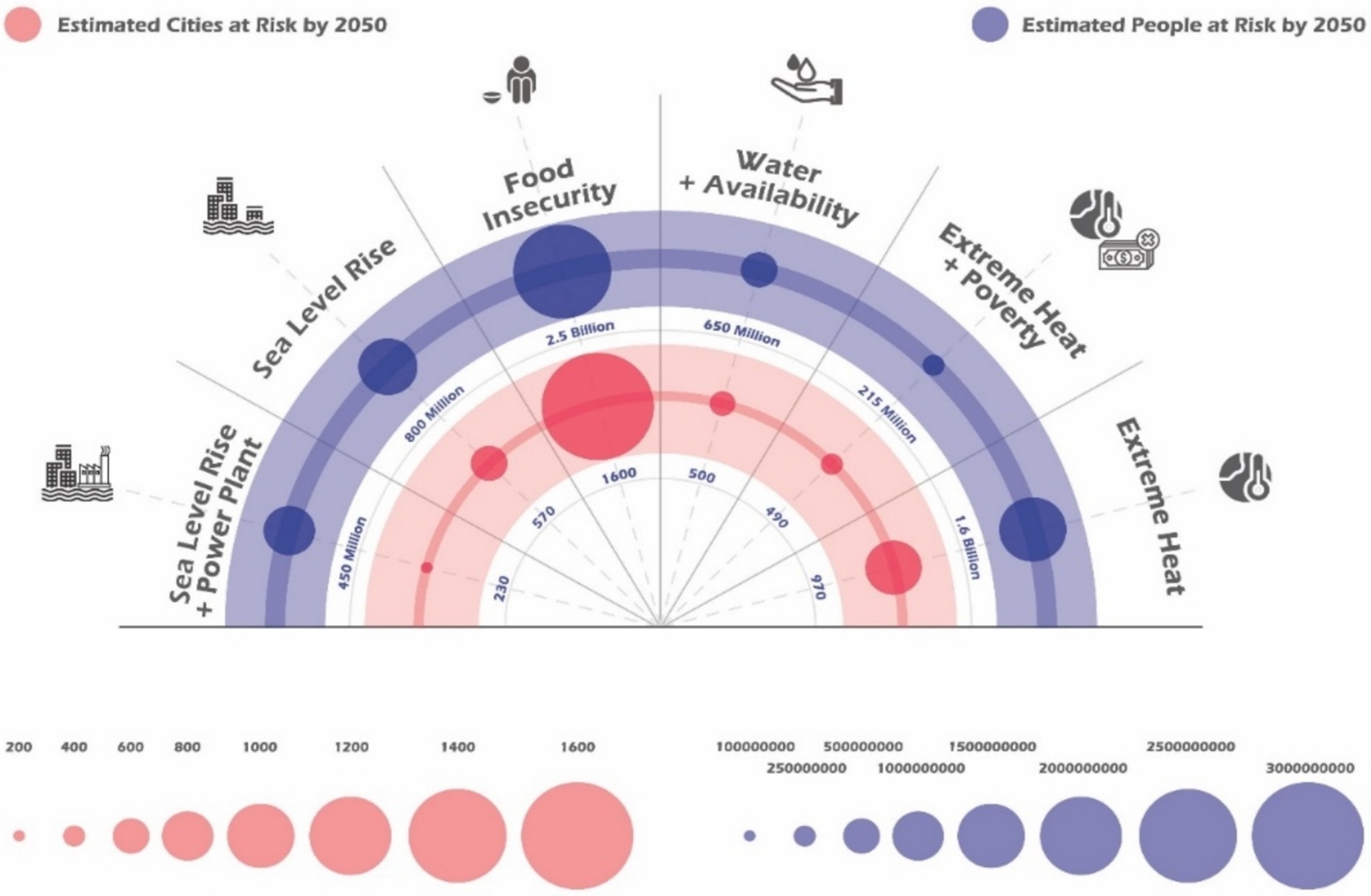
Figure 1. A summary of critical risks that cities and their residents will encounter due to climate change. Source: Based on data from C40 Cities (2019).
Approximately 80% of anthropogenic-based emissions are produced in urban areas (Chen et al., 2020; Li et al., 2021), and one-third is primarily from Land Use and Cover Change. Given the inevitability of urbanization, the dire need to account for, model, and strategize mitigation measures to reduce consumption and exploitation and create sustainable urban development has become a common goal for urban decision-makers (Wang and Deng, 2015).
UM is the study of interactions involving energy flows, people, and the information they carry in an urban landscape that leads to complex socioeconomic, sociotechnical, and socioecological processes from a global to local scale (Cartiaux et al., 2018; Curie and Musango, 2016; Teixeira et al., 2021; Schmidt et al., 2022; Lu et al., 2024). Wolman (1965) developed the UM concept for the first time by comparing a city to an organism. Metabolism of a city includes various dimensions such as urban form/spatial pattern, its urban governing body, and socioeconomic and sociocultural aspects, thereby identifying gaps in sustainability and urban issues with the transformation of its materials and energy (Bahers et al., 2019; Rosado et al., 2017). It defines a broad and assimilated system of interest and provides essential insights for sustainable urban planning and management (Restrepo et al., 2018; Teixeira et al., 2021). Urban Metabolism is the study of interactions that includes energy flows, people, and the information they carry in an urban landscape that leads to complex socioeconomic, sociotechnical, and socioecological processes from a global to local scale (Cartiaux et al., 2018; Schmidt et al., 2022). It can assist in defining a broad and assimilated nexus system of interest, and important insights for sustainable urban planning along with management can be brought by this integration (Teixeira et al., 2021; Restrepo et al., 2018). Hence, there has been a remarkable evolution in the quantification of resource flow to build resource-efficient cities. In recent years, the UM idea has been employed progressively in an extensive range of sectors as a method to examine and formulate city strategies. Hence, this approach identifies the dynamic urban pattern of a city along with the nature of economic-socio-environmental urban diaspora. As the distinctive nature of a city is its linear form of resource flows, the challenge of the current era is the shift toward a cyclical network approach for self-sustainability (Musango et al., 2017; Galán-Cano et al., 2025) (Figure 2).
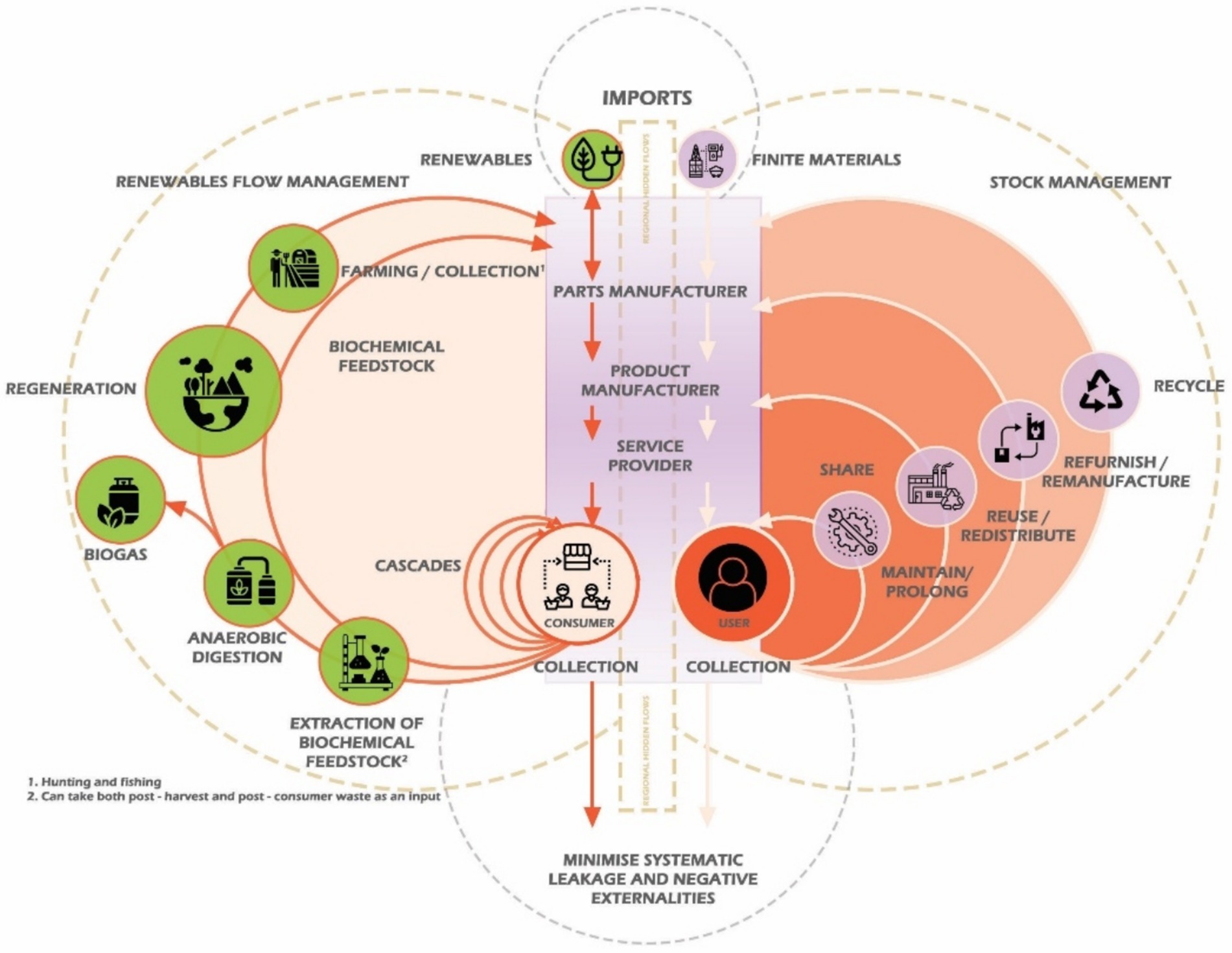
Figure 2. Outline of a circular economy. Source: Based on data from Ellen MacArthur Foundation (2015).
In earlier UM studies, the designed framework was used to analyze the city’s input–output relationship with its surrounding environment and to achieve balanced, regularized, and functioning urban systems (Decker et al., 2000; White, 1994). UM researchers realized the complexity of socioeconomic systems and dissected the study to quantify the flow of a single resource, such as water (Serrao-Neumann et al., 2019; Serrao-Neumann et al., 2017), energy (Kuznecova et al., 2014; Barrera et al., 2018; Carreón and Worrell, 2018), nitrogen (Forkes, 2007; Pan et al., 2020), food (Tseng and Chiueh, 2015; Villarroel Walker et al., 2014), etc.
In future, studies are further expected to embark on this trend of dividing the components into finer fractals (Wang et al., 2023). UM concept further aided in assessing the climate change impact and quantifying carbon emission flows to measure emissions due to socioeconomic activities related to infrastructure such as transport and energy use (Kennedy et al., 2011; Kennedy et al., 2010). UM studies provide cross-disciplinary interventions across different urban systems that contribute to urban sustainability (Wang, 2023; Lu et al., 2024). Hence, to achieve enhanced resource management, urban management systems must take combined resource efficacy initiatives despite the challenges of engendering robust cities. Although there are studies that provide the metabolic profile for a region, the influence of urban socioeconomic activities becomes the passive actor in defining the metabolic types and their interrelations (Rosado et al., 2017; Wang, 2023). Yet, there has been no study on the nature of urban systems and their practical implications in developing nations, creating a research gap and the need to use it as a tool to evaluate frameworks such as SDGs that influence global and national policies (Figure 3).
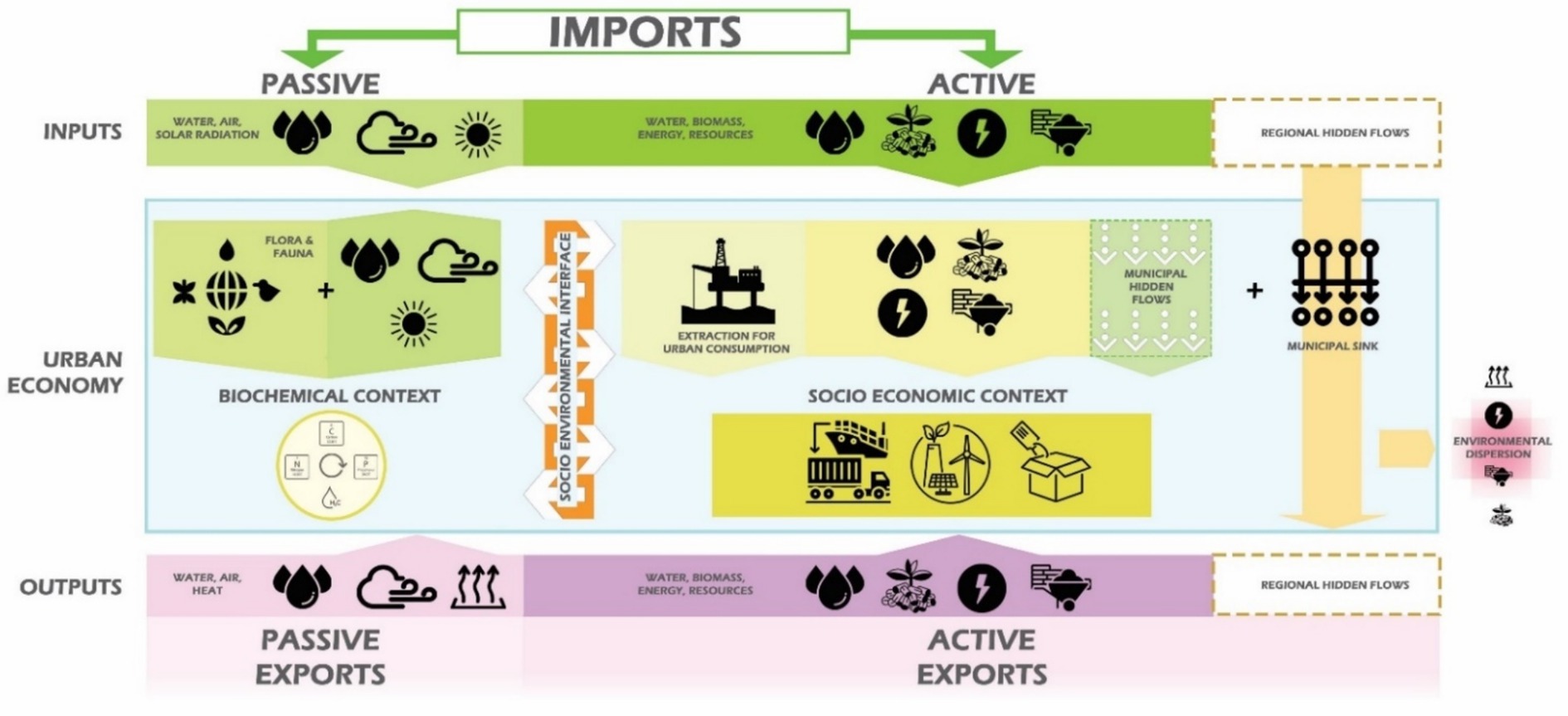
Figure 3. Urban metabolism framework. Source: Based on data from Ferrão and Fernández (2013).
The first half of the article tries to delve into case studies and identify the nature of urban metabolic systems via the method used by Wang (2023), wherein an adaptive approach of technical cases was collected and manually reviewed to understand the trend in the concept and the need for UM lens to identify the lacunae in the application of SDGs at the regional context for the implication of effective policy landscape. Hence, the article addresses factors influencing UM at two different scales, with two distinct narratives to address completely different issues under the same component. The second half of the article explores the application of the concept in current studies, wherein the findings from the ‘perspective methods’ were aligned to standard guidelines that were collected, and its limitations were identified to help reduce the gap in effective implementation between researchers and practitioners, inferring the need to take an integrated approach in policies, framework, guidelines, etc. Hence, UM is suggested as an effective tool to address regional disparity and a better means to devolve powers to local planning institutions.
2 Materials and methods
It is to be noted that this study does not encompass all studies done so far in this field of research, as the goal is to identify the innate nature of Urban Metabolic Systems and to use it as a tool to find the wide differences in approaches under the same component due to the sociopolitical-economy framework of the region, especially in a developing nation. To perform this research, rather than repeating comprehensive reviews done so far, cases from two critical pieces of literature were assembled up to 2023, and an adaptive approach was adopted similar to Wang (2023). The data cases from two pieces of literature were used for this approach as there was not much research made recently within the scope of this study, and the technical aspect of the literature review was already covered. The collected data are critical to explain what UM methods should be used in various research contexts. Both the literature works review the empirical methods applied and act as a guide to methodological approaches. This study identifies itself as an extension of the following research works, as mentioned in Figure 4.
i. The first study by Wang et al. (2023) gives a comprehensive description of recent interventions of UM studies in industrial ecology (as it is the new core of the concept) from the ‘Perspective of Methods’ approach compared to earlier studies on specific components. This study procured data from Elsevier’s Scopus database, dated till April 2023, and gathered literature of 482 articles suitable for the study. The results from this study address the extent to which UM prediction analysis is done and further identify works done globally on the urban metabolic network that effectively reveals the multi-scale linkage of the urban systems. Consequently, this research served as the foundation for this study to explore the interconnections among various metabolic systems and to classify the characteristics of these systems further.
ii. The second study by Wang et al. (2021) provides a systematic review of the current trends and multi-disciplinary perspectives on various metabolic flows and methods derived from 1,084 publications related to UM studies by structuring the evolution of the concept, thereby drawing insights toward the analysis of urban systems for effective identification of Urban Political Economic (UPE)-based complexities and the need for an evolved SDGs framework.
Furthermore, the collected materials were manually reviewed for their titles based on the topic’s relevance to the study, and irrelevant publications were eliminated. A total of 518 publications (Supplementary Material 1) were used as the base data for the study. From the collected cases exclusive to this study, research on UM became active between 2010 and 2019 and contributed close to 69% of the total publications (Supplementary Material 2). During this period, studies on resource consumption as a metabolic system increased 10 times from the previous decade, yet escalation in research is expected as this is the crux of the concept. ‘Economic Ecology’ had an unexpected increase in publications (~7 times), as these studies identified synergistic opportunities for mutual relationships between neighboring industries with regional discrepancies. Initially, two metabolic systems (Urban Systems – 31.8% + Resource Consumption Pattern – 43.8%) contributed to most of the research, as they were core sections of the concept, and slowly shifted toward ‘Industrial Ecology’. Furthermore, the nature of these components helped in the identification of gaps in the national framework, influencing effective policy-making.
3 Findings and discussions
3.1 Factors influencing the nature of UM systems
Identifying factors that impact the flows within a city is integral to UM studies. Sociodemographic factors (e.g., income inequality due to accessibility of education, culture, etc.) reflect consumption preferences and patterns and their influence on accessibility, accountability, and inclusivity (Lyons et al., 2018). The dynamic transformation in culture, economy, infrastructure, technology, environment, and climate is closely related to these trends (Dijst et al., 2018; Geremicca and Bilec, 2024), indicating the dire need to adopt it as a tool. The following section is viewed at two levels—the global (international context) and national (Indian context)/regional—and touches upon subjects rarely represented in UM studies at each level and addresses two tangents within the same category. The upcoming subsections have some overlapping concepts that are categorized for ease of understanding. Within the same subsection, different issues are addressed based on the current urban political economy, which gives an overview of how gaps occur when establishing strategies. For example, there is a significant focus on industrial integration and increasing infrastructure in the Indian context (developing nation) to achieve self-sufficiency and generate a better revenue stream, whereas, at the global scale, this level of infrastructure is already attained and moving toward resolving advanced challenges for integrating Information and Communication Technology (ICT) and governance. These inferences reflect the need to use such tools to identify the problem at micro-scale to provide policies that aid in devolving its power to the local planning authority.
3.1.1 Urban systems: patterns, real estate dynamics, and statutory provisions
Understanding the characteristics and influences of material flows in an urban environment is crucial, as local factors have the greatest impact on achieving sustainability. When urban systems are viewed from a systems perspective, efficient land use of cities is an integral factor in reducing the negative entropy and regulating the sustainable metabolic flow of material and energy. UM research focuses on creating categorization systems, determining the metabolic profiles of urban areas, and examining trends and transitions in different stages of city expansion, which will give insights into land management policies (Figure 5).
UM of materials and the influence of urban patterns have been studied using spatially explicit models and overlaid with material flow analysis (Bahers et al., 2019; Zhang et al., 2016). These models range from material impact assessment (Bahers and Rosado, 2023; Delivandani et al., 2021; Rosado et al., 2017) to carbon metabolism within a region (Li et al., 2021; Xia et al., 2017; Zhang et al., 2018a), including network analysis (Li et al., 2019; Xia et al., 2018). In developing countries, urban patterns and systems are also determined by income disparities and correlating real estate dynamics.
A global study indicated that the automobile urban fabric model demanded more basic raw material (BRM) (288 tons/person) than the transit urban fabric (189 tons/person) and also found that walking urban fabric (147 tons/person) required 10 times more additional materials for low-density dwellings with its supporting infrastructure (Thomson and Newman, 2018). However, the amount of food, fuel, water, and land consumed by individuals yearly did not change as there was no “Technology Plus Construction Innovation,” despite the change in occupancy level (Thomson and Newman, 2018). This proves that studies using temporal land use matrices are insufficient to achieve regenerative goals. At a global scale, discussions on Green sustainability stewardship with social equity and wellbeing are part of SDG 11, wherein the goal is to make cities and settlements inclusive, secure, resilient, and sustainable. This again becomes challenging when the urban political economy is integrated, considering the requirement of the multi-faceted approach.
At the national level, the Indian real estate market by 2030 is expected to reach $1 trillion in value and begin to contribute 13% of the country’s Gross Domestic Product (GDP). The Economic Survey 2018–2019 predicts that by 2031, there will be 600 million people worldwide. It will not be possible to accommodate the 223 million additional urban residents by 2031 if the rental housing market is not developed (Zia, 2019). An inadequate supply of affordable housing with appropriate infrastructure under SDG 11.1 is a major factor in the growth of slums and informal settlements, which house nearly half the population in many cities. The affordability of the real estate market will determine that the urban sprawl as properties in peri-urban areas are more budget-friendly than those in the urban core and require SDGs to address the integration of Real Estate Regulatory Authority (RERA) with policies. Another aspect is that in the case of Delhi, its low ‘Rental Yield’ is mainly due to the high property prices relative to the rental income with other factors such as limited rental housing stock, cultural preferences for home ownership, and most importantly, based on the political situation, the tenant–landlord regulation of the metro cities with low interest rates on fixed deposits.
Hence, UM studies highlight the need to focus on resource distribution and other infrastructure services to determine material consumption. Addressing it wholistically provides a better scope for developing a framework for more efficient, inclusive, regenerative cities (Figure 6).

Figure 6. Rental yields across selected two BHK properties in major Indian cities. Source: Reproduced from Zia (2019), with permission.
3.1.2 Transport and logistic systems
UM studies on transportation and logistics have examined sustainability measures (Meng et al., 2016) via interspatial analysis to quantify energy consumption and GHG emissions from the transport sector (Khalil et al., 2021; Kissinger and Stossel, 2021; Kissinger and Stossel, 2019). They also cover the interdependency of a region (Khalil et al., 2021; Pianegonda et al., 2022) with metabolic location value based on the spatial distribution of assets with travel time and cost (Braham and Lee, 2020). A global study found that, despite a railway station located within the district, results showed that very few users (0.7%) in Zamalek relied on the subway, except for some commercial users (6.8%), reflecting the overall community preference. A similar perspective was used to understand the location value of land parcels in the greater Philadelphia area by reinforcing urban connectedness via energy analysis (Braham and Lee, 2020). The CBD area had a lower life cycle of the urban neighborhood (0.25–0.5) than the adjacent neighborhood region (0.6–0.97), identifying pockets suitable for regeneration (Braham and Lee, 2020). This approach can also be applied to create sustainable cities. Global studies are keenly working toward achieving SDG 11.2, which fosters pedestrian-friendly environment, as they have already achieved sustainable industrial practices (Figure 7).
Meanwhile, in the urban political economy front of the Indian context, The Export Preparedness Index Report 2021 revealed that states such as Gujarat, Chandigarh, and Punjab scored highly in the LEADS1 index score (based on SDG 9) and performed poorly under Pillar 2: Business Ecosystem. Karnataka and Delhi scored higher as they had well-established air cargo facilities, multi-modal logistic hubs, and inland container depots. Establishing sustainable logistics infrastructure is a better investment when social costs are considered; however, for developing nations, it is possible to procure such money only when they are economically robust, wherein their competitive positioning of exports is checked based on the value chain carbon footprint for economic development.
3.1.3 Economic ecology: industry, connectivity, and industrial linkages
The current industrial economy is undergoing significant changes via industrial convergence and agglomeration, each possessing distinct attributes. This creates a sustainable stream via agglomeration economies of scale and cost-cutting in transportation, transactions, and technology with cost innovations. Metabolic studies related to industrial metabolism have been specific to a particular industry, e.g., construction industry (Wang et al., 2018; Zhang et al., 2018b), or focused on the traditional and advanced method of network analysis (Fan et al., 2017; Gan et al., 2023; Tian et al., 2022) and calculation of industrial waste (Gambarotto et al., 2022; Hua et al., 2023) (Figure 8).
Quantitative and qualitative economic linkage approaches at the global level reveal mutualism and synergism between industries, creating more resource and energy-efficient systems. The mutual relationship of integral flows between the system compartments reveals the system’s synergistic opportunity to make it more holistic and robust (Fan et al., 2017; Gan et al., 2023). It was found that Tiajin, a structured city in China, accounted for 54 and 62% of the exploitative relationship between common industrial solid waste (CSIW) and hazardous waste generation, respectively, from industrial sectors such as chemical, metal-based, and production and supply of heat industries. A socioeconomic metabolism approach (Hua et al., 2023) identifies the type of synergistic relationships, such as a mutual relationship, wherein there is a positive correlation between two industries, leading to the reduction of resource consumption or waste generation, one after another. In the case of an exploitative relationship, there is a negative association, i.e., reducing waste in one industry alters the intersectoral supply chain of another, generating more waste. In a competitive relationship, the industrial output is mutually inhibited, which is an ideal state for achieving sustainability. Such an approach can help in accounting for resource input–output based on the type of relationship and identification of management hotspots that could be integrated as a part of SDG 9.4 to retrofit industries and overall industrial master plan for increased resource use efficiency, which requires flexible regulations and seamless operation.
Industrial estimates, in Urban Political Economy context, suggest that India’s logistics and supply chain costs represent 13 to 14% of GDP, compared to 8 to 10% in developed countries; thus, the nation is targeting to reduce it to 10%. Cost reduction is the vital focal point, with the expected export competitive growth of 1 trillion dollars by 2028 from 422 billion in 2022 (Gambarotto et al., 2022). The International Plant Protection Convention and the Joint FAO/WHO Codex Alimentarius Commission have set global standards for exporting agricultural products, although individual nations may establish their standards. Globally, approximately 500,000 tons of food are treated annually; however, only one facility in India has been approved by the U.S. Furthermore, India’s resource demands are primarily domestic; hence, the export business is relatively smaller with added disadvantages such as infrastructure and logistics. NLP (National Logistics Policy) must be integrated with the surrounding testing facilities in its master plan via SDG 9 to develop an agglomerated industrial setup for a viable investment. Hence, this proves that the approach required for effective implementation differs from theoretical methods.
3.1.4 Economic infrastructure, inequality, and accessibility
The urban infrastructure carrying capacity of functional infrastructure (e.g., water, gas, or transportation-based infrastructure) has been evaluated by integrated approaches of mean–variance analysis and coupling coordination degree (Wang et al., 2020; Zhou and Jiang, 2019), which aided in identifying cities that are fluctuating due to the dynamic nature of load and carrier indicators. In the case of the urban nexus of resources, identifying gaps in the interdependencies with their climatic, geopolitical, and socioeconomic drivers can help policymakers and stakeholders design policy via cost–benefit–risk trade-offs (Valencia et al., 2022) (Figure 9).
Investments in global economic infrastructure, an important aspect of urban political economy (e.g., Industrial parks, Special Economic Zones, and Tourism facilities), can positively impact urban infrastructure carrying capacity performance as it stimulates urban economic growth. A study that surveyed 35 cities in China (Wang et al., 2020) found that the performance increased μ1 0.1435 in 2008 to 0.1832 in 2017 due to investment in infrastructure delivery with the latest technology and reinforcing urban infrastructure carriers to benefit urban resilience. However, embracing uncertainty for various possible futuristic scenarios, where the risk could be a cooperative and close scenario in the case of physical connectivity or a global–local scenario in the case of digital connectivity (Lyons et al., 2018; Geremicca and Bilec, 2024), based on the lifestyle expressions of the people, “whole system” thinking is ideal for encouraging physical accessibility, spatial relatedness, and digital connectedness. The centripetal and centrifugal forces are not just affected by regulatory or market incentives to invest in urban ICT infrastructure; initiatives by policymakers to develop more collaborative consumption of resources can also lead to more socially resilient and environmentally sustainable solutions. UM studies have transitioned from the first intradisciplinary wave to the second wave focusing on integration; a third wave focusing on inclusivity and codesigning with communities is now emerging. Thus, adapting to the upcoming third wave of UM assessment as part of SDG 11 is similar to Amsterdam’s Circular Strategy by Municipality of Amsterdam where there is active involvement of locals, as there is no tailor-made approach to analyze informal settlements.
The basic key infrastructure implementation agency and other regulatory guidelines must be seamlessly coordinated in developing nations. This means that physical accessibility and spatial relatedness must be achieved first. Indian cities typically grow horizontally compared to other cities. The SDG 11 indicators refer to the accessibility and affordability of housing and transport systems, with indicator 11.3 broadly focusing on sustainable urbanization. However, the “sustainable urbanization” scope in an urbanized area should also focus on the regeneration model (Figure 10).
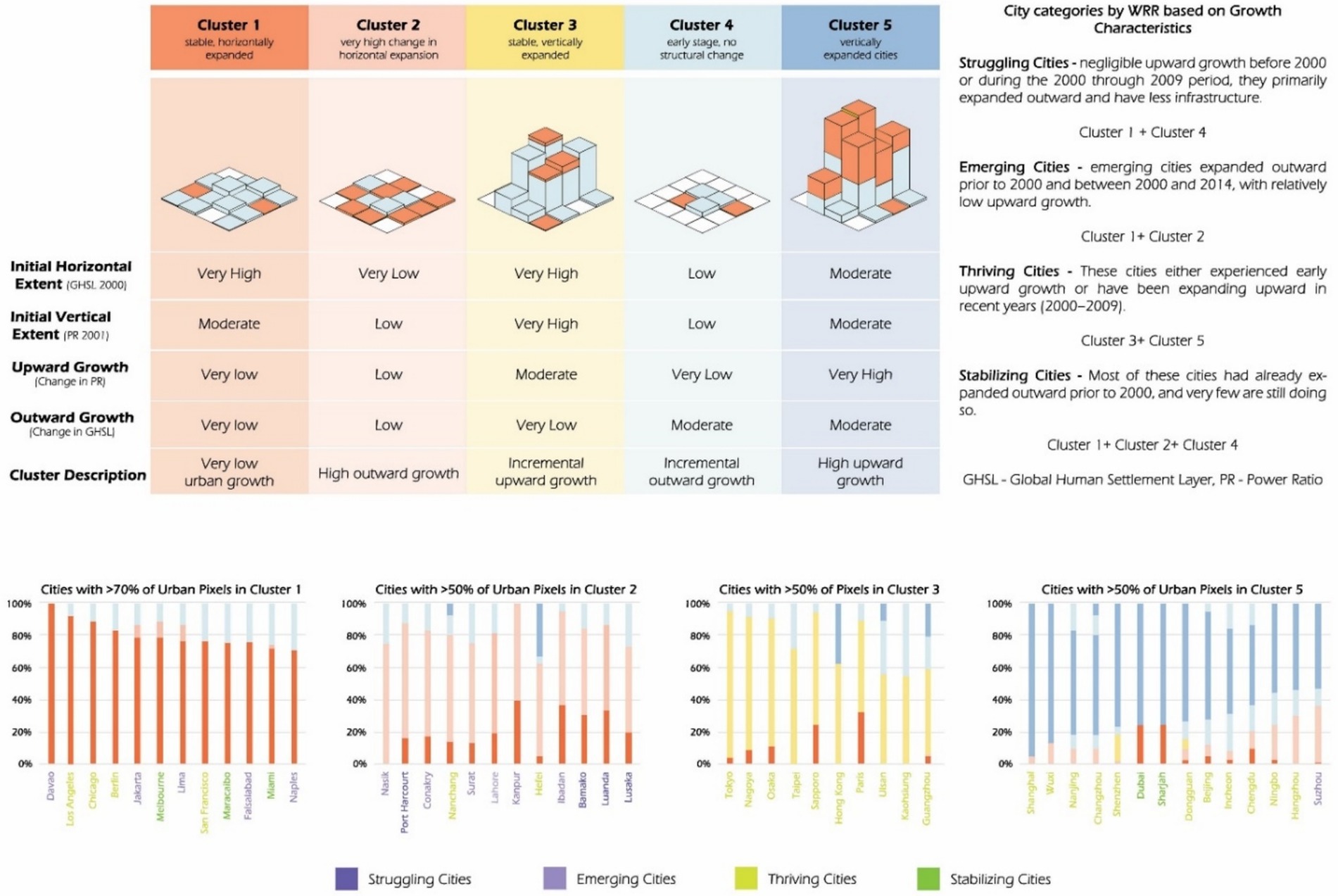
Figure 10. Built-form clusters are used to characterize urban growth patterns. Source: Reproduced from Mahendra and Seto (2019) under CC BY 4.0 license.
For example, the Metro rail system in India linked land value capture of the transport infrastructure finance framework with the Transit - Oriented Development (TOD) policy, thereby establishing sustainable urban growth centers integrated with robust transit systems. To attain comprehensive development, the policy allows for an increased Floor Area Ratio (FAR), consequently enabling vertical development. Other than Mumbai, the guideline value (reference value for land value) is not linked to property tax or development charges (an aspect of UPE, as regulations vary in different metro cities) to maintain nominal values (Asian Development Bank, 2022) (Table 1).
3.1.5 Resource consumption, governance, and health
Integrated analysis, such as material footprint with multi-regional input–output, effectively accounts for the externalization of UM and required intervention in urban circular economic policies. When considering a degrowth perspective (Bahers and Rosado, 2023), initiatives by Amsterdam’s Circular Strategy, Municipality of Amsterdam, that focused on the regional value chain of food, construction, and textiles deal only with the resource stock, not with its downscaling (Cui, 2022; Henrysson et al., 2022; Lucertini and Musco, 2020; Savini, 2023; Wang et al., 2022) (Figure 11).
In resource consumption from a global socioecological perspective, Fróes and Lasthein (2020) described that a healthy city recognizes and deals with the intricate interdependence of its various actors, allocating resources to maintain a constant, robust flow of its metabolism. The policy determines urban political economy from its recommended budgets for all planned urban development projects, which require urban prototypes and design spaces such as city labs to educate individuals about their resource needs and the implications of the general flow of commodities and transportation in cities.
Meanwhile, in the Indian UPE context, it is estimated that by 2025, the government wants to spend nearly 2.5% of the nation’s GDP on public health. India’s Foreign Direct Investment (FDI) regime in the pharmaceutical industry has undergone significant liberalization; under the automatic route, FDI is now permitted up to 100% in greenfield projects and 74% in brownfield projects. Currently, China is the source of up to 80% of India’s Active Pharmaceutical Ingredients (APIs) imports. India’s healthcare sector comprises hospitals supported by clinical trials, medical equipment and health insurance, medical tourism, and telemedicine. These market segments are expected to diversify with an aging population and penetrate more to the vulnerable sects of society. The policies via Aatmanirbhar Bharat Abhiyaan packages and SDGs for India include several short- and long-term health system advancements, such as Production-Linked Incentive schemes to increase domestic production of pharmaceuticals and medical equipment. A general policy framework only touches upon resource consumption; in contrast, it is necessary to focus on whether the resource use is inclusive and reaches the vulnerable sectors of society by considering the purchase disparity and accessibility of resources (Figures 12–14).
3.2 International urban metabolism standards
This section identifies literature on the assessment of metabolic status via city strategies, quality of city services, smartness, and sustainability, which are integral aspects of UM studies. It was found that although city assessment tools or standards related to smartness address social and economic aspects of sustainability, they rarely are related to environmental sustainability. Additionally, there is a dire need for framing assessment tools, especially for developing nations. Each study is examined to check if it addresses the following aspects that were found to be the limitations in the current policy framework and became the key targets to achieve sustainability, especially for developing nations: accessibility, social inequality, local scale, geographical inequality, diversity, green building, low-carbon city, sustainable development, and politicized production. Each factor assesses the decentralization of various sectors and the extent to which power is devolved to local planning authorities for a more sustainable and effective governance.
Janik et al. (2019) identified the following as the most comprehensive frameworks: (i) City Protocol is a comprehensive system that embraces city-centered concepts to efficiently deliver services and enhance the quality of life for its residents. (ii) CITYkeys—developed as part of the EU project, the framework was designed for the H2020 program to foster smart cities, encompassing the monitoring and implementation of smart city initiatives. (iii) ITU-T Y.4903/L.1603—city’s performance assessment to achieve smart, sustainable goals (Janik et al., 2019). While these standards acknowledge the diversity of its citizens, it is crucial to enhance the city’s resilience by considering the diversity of its infrastructure, facilities, revenue generation, and investments. The following illustration exhibits the limitations of the current assessment tools (Ahvenniemi and Huovila, 2021; Hajduk and Jelonek, 2021; Janik et al., 2019; Ko and Chiu, 2020; Ness and Xing, 2020; Shmelev and Shmeleva, 2019).
3.3 Urban metabolism infrastructure–global context
This section reviews literature that addresses urban metabolic infrastructure systems. Studies have solely focused on resource demand for current and future scenarios, for example Renouf et al. (2018) quantified the water performance of urban areas by overlaying land use data over hydrological flow partition factors. Ideally, to develop more resilient strategies, it is important to address the diversity of infrastructure availability and understand the geopolitical nature of resource distribution for decentralized governance (Barragán-Escandón et al., 2017; Baynes and Musango, 2018; Renouf et al., 2018; Serrao-Neumann et al., 2017; Zasada et al., 2019; Rusca et al., 2022; Szmelter-Jarosz et al., 2020).
3.4 Urban metabolism infrastructure–Indian context
This section highlights literature on specific urban metabolic infrastructure systems in the Indian context, as a case study for developing nations. The studies analyze the geographic characteristics using multiple systems networks or networks in periurban areas. For example, Paul (2020) identified geographic factors that influence the livability potential of the Kolkata Metropolitan area for an advanced, resilient approach, identifying the need to quantify system redundancy and robustness (Ghosh et al., 2021; Sukhwani et al., 2020; Paul, 2020; Mourya et al., 2021; Sahana et al., 2018; Allen et al., 2017; Ghosh et al., 2019; Lehmann, 2018; McFarlane et al., 2017; Sen et al., 2019). Hence, when the policy framework is designed, the regional-level institutional unit, along with SPV, is required to be considered to avoid issues regarding implementation-based regional disparity.
The gap found in the study has a wholesome approach to addressing the nine parameters that have not been considered for an efficient and sustainable implication for urban political economy-based policy framework from a bottom-up approach perspective. This can be largely found in the smartest city program, e.g., Pedestrian-friendly projects in Pune, Bengaluru, Chennai, Cochin, etc.
3.5 Limitations
This study is limited to the Indian context as it adheres to the current on-ground practical implications for implementation as cities are dynamic, and with time, the same factors considered would become irrelevant for the study. Furthermore, exploration regarding the practical implementation of the devolution of power to local planning institutions is required. There are some advanced methods to review the urban metabolic profile using geospatial tools, such as GIS with a system dynamic approach, that can be integrated with the urban political economy of the study region for effective development of policy framework. More studies related to niched aspects of Urban Political Economy based Urban Metabolism studies are required to bring practical solutions.
4 Discussions and conclusion
UM studies provide a holistic view of the complex relationships and patterns of resource flows in addition to taking an accounting-based approach and are found to be an effective tool to take a deeper lens to address disparity at the regional level. In future, research scholars, urban planners, and other decision-makers need to work on finer spatial units and achieve multi-level metabolic networks wherein a multi-scale associative coupling is necessary for more integrated and efficient control of metabolism. For a sustainable transition, it is essential to find the potential of an emerging economy, as the global transition from agro- to industrial-based economies has affected material flow patterns. Additionally, enhancing the quality of life necessitates strategies targeting resource consumption, waste reduction, and management. Hence, the real challenge in developing a policy framework for sustainable urbanization is a seamless amalgamation between different stakeholders for practical implications, as the study is not limited to just the identification of metabolic infrastructure services but should also consider the underlying factors that influence them.
This article examines case studies that apply to planning practices and how a more sustainable approach can be taken to create resilient systems. It is noted that the same urban-based concerns at various scales have different impacts, entailing both resource-based and service-oriented analyses. Over time, new urban challenges can only be addressed by an advanced and multi-faceted approach to UM as a lens, where the goal is to achieve an ameliorated version of sustainable systems and find a center between sustainability and regional economic consciousness.
Author contributions
RZ: Conceptualization, Formal analysis, Investigation, Methodology, Software, Visualization, Writing – original draft. GM: Supervision, Validation, Writing – review & editing.
Funding
The author(s) declare that no financial support was received for the research and/or publication of this article.
Acknowledgments
The researcher is awarded a scholarship by the AICTE Doctoral Fellowship with Reference no.: 22256191101/Ph.D/AR13 of Anna University, India, which is gratefully acknowledged.
Conflict of interest
The authors declare that the research was conducted in the absence of any commercial or financial relationships that could be construed as a potential conflict of interest.
Generative AI statement
The authors declare that no Gen AI was used in the creation of this manuscript.
Publisher’s note
All claims expressed in this article are solely those of the authors and do not necessarily represent those of their affiliated organizations, or those of the publisher, the editors and the reviewers. Any product that may be evaluated in this article, or claim that may be made by its manufacturer, is not guaranteed or endorsed by the publisher.
Supplementary material
The Supplementary material for this article can be found online at: https://www.frontiersin.org/articles/10.3389/frsc.2025.1538006/full#supplementary-material
Footnotes
1. ^LEADS evaluates international trade logistics across Indian states and UTs based on user and stakeholder perceptions. Additionally, it offers indicator-level evaluations of the performance on particular dimensions.
References
Ahvenniemi, H., and Huovila, A. (2021). How do cities promote urban sustainability and smartness? An evaluation of the City strategies of six largest Finnish cities. Environ. Dev. Sustain. 23, 4174–4200. doi: 10.1007/s10668-020-00765-3
Allen, A., Hofmann, P., Mukherjee, J., and Walnycki, A. (2017). Water trajectories through non-networked infrastructure: insights from Peri-urban Dar Es Salaam, Cochabamba and Kolkata. Urban Res. Pract. 10, 22–42. doi: 10.1080/17535069.2016.1197306
Asian Development Bank (2022). Realizing India’s potential for transit-oriented development and land value capture: a qualitative and quantitative approach. Philippines: Asian Development Bank.
Bahers, J.-B., Barles, S., and Durand, M. (2019). Urban metabolism of intermediate cities: the material flow analysis, hinterlands and the logistics-hub function of Rennes and Le Mans (France). J. Ind. Ecol. 23, 686–698. doi: 10.1111/jiec.12778
Bahers, J.-B., and Rosado, L. (2023). The material footprints of cities and importance of resource use indicators for urban circular economy policies: a comparison of urban metabolisms of Nantes-Saint-Nazaire and Gothenburg. Clean. Prod. Let. 4, 100029–100010. doi: 10.1016/j.clpl.2023.100029
Barragán-Escandón, A., Terrados-Cepeda, J., and Zalamea-León, E. (2017). The role of renewable energy in the promotion of circular urban metabolism. Sustain. For. 9:2341. doi: 10.3390/su9122341
Barrera, P. B., Carreón, J. R., and De Boer, H. J. (2018). A multi-level framework for metabolism in urban energy systems from an ecological perspective. Resour. Conserv. Recycl. 132, 230–238. doi: 10.1016/j.resconrec.2017.05.005
Baynes, T. M., and Musango, J. K. (2018). Estimating current and future global urban domestic material consumption. Environ. Res. Lett. 13:065012. doi: 10.1088/1748-9326/aac391
Braham, W. W., and Lee, J. M. (2020). Metabolism of urban location: travel time and the morphology of cities. Front. Sustain. Cities 2, 1–13. doi: 10.3389/frsc.2020.00004
Carreón, R. J., and Worrell, E. (2018). Urban energy systems within the transition to sustainable development. A research agenda for urban metabolism. Resour. Conserv. Recycl. 132, 258–266. doi: 10.1016/j.resconrec.2017.08.004
Cartiaux, N., Mazzocchi, G., Marino, D., and Jijakli, H. (2018). Improving urban metabolism through agriculture: an approach to ecosystem services qualitative assessment in Rome. Toulouse: Jean Jaures University.
Chen, S., Chen, B., Feng, K., Liu, Z., Fromer, N., Tan, X., et al. (2020). Physical and virtual carbon metabolism of global cities. Nat. Commun. 11:182. doi: 10.1038/s41467-019-13757-3
Cui, X. (2022). A circular urban metabolism (CUM) framework to explore resource use patterns and circularity potential in an urban system. J. Clean. Prod. 359:132067. doi: 10.1016/j.jclepro.2022.132067
Curie, P. K., and Musango, J. K. (2016). African urbanization: assimilating urban metabolism into sustainability discourse and practice. J. Ind. Ecol. 21, 1262–1276. doi: 10.1111/jiec.12517
Decker, E. H., Elliott, S., Smith, F. A., Blake, D. R., and Sherwood Rowland, F. (2000). Energy and material flow through the urban ecosystem. Annu. Rev. Energy Environ. 25, 685–740. doi: 10.1146/annurev.energy.25.1.685
Delivandani, F., Rajabi, A., and Kermani, A. N. (2021). Process-based improvement of urban metabolism in optimizing the development cycle of the Small City using MIA method. Math. Probl. Eng. 2021, 1–13. doi: 10.1155/2021/5545307
Dijst, M., Worrell, E., Böcker, L., Brunner, P., Davoudi, S., Geertman, S., et al. (2018). Exploring urban metabolism—towards an interdisciplinary perspective. Resour. Conserv. Recycl. 132, 190–203. doi: 10.1016/j.resconrec.2017.09.014
Ellen MacArthur Foundation (2015). Towards a circular economy: business rationale for an accelerated transition. Available online at: https://www.ellenmacarthurfoundation.org/towards-a-circular-economy-business-rationale-for-an-accelerated-transition (accessed 23 April 2025).
Fan, Y., Qiao, Q., and Fang, L. (2017). Network analysis of industrial metabolism in Industrial Park – a case study of Huai’an economic and technological development area. J. Clean. Prod. 142, 1552–1561. doi: 10.1016/j.jclepro.2016.11.149
Ferrão, P., and Fernández, J. (2013). Sustainable Urban Metabolism. The MIT Press Ser. Cambridge: MIT Press
Forkes, J. (2007). Nitrogen balance for the urban food metabolism of Toronto, Canada. Resour. Conserv. Recycl. 52, 74–94. doi: 10.1016/j.resconrec.2007.02.003
Fróes, I., and Lasthein, M. K. (2020). Co-creating sustainable urban metabolism towards healthier cities. Urban Transform. 2:5. doi: 10.1186/s42854-020-00009-7
Galán-Cano, L., Cámara-Aceituno, J., Hermoso-Orzáez, M. J., Mena-Nieto, Á., and Terrados-Cepeda, J. (2025). Urban metabolism, sustainability and energy transition in cities: a comprehensive review. Results Eng. 25:104278. doi: 10.1016/j.rineng.2025.104278
Gambarotto, F., Magrini, C., Pedrini, G., and Stamboglis, N. (2022). How to map industrial waste metabolism at a geographical level? A proposal for a composite Indicator. J. Clean. Prod. 379:134681. doi: 10.1016/j.jclepro.2022.134681
Gan, L., Xue, W., Ma, Y., and Lev, B. (2023). Efficiency evaluation for urban industrial metabolism through the methodologies of Emergy analysis and dynamic network stochastic block model. Sustain. Cities Soc. 90:104396. doi: 10.1016/j.scs.2023.104396
Geremicca, F., and Bilec, M. M. (2024). Searching for new urban metabolism techniques: a review towards future development for a City-scale urban metabolism digital twin. Sustain. Cities Soc. 107:105445. doi: 10.1016/j.scs.2024.105445
Ghosh, R., Kansal, A., and Venkatesh, G. (2019). Urban water security assessment using an integrated metabolism approach—case study of the National Capital Territory of Delhi in India. Resources 8:62. doi: 10.3390/resources8020062
Ghosh, S., Chatterjee, N. D., and Dinda, S. (2021). Urban ecological security assessment and forecasting using integrated DEMATEL-ANP and CA-Markov models: a case study on Kolkata metropolitan area, India. Sustain. Cities Soc. 68, 102773–102715. doi: 10.1016/j.scs.2021.102773
Hajduk, S., and Jelonek, D. (2021). A decision-making approach based on TOPSIS method for ranking smart cities in the context of urban energy. Energies 14, 1–23. doi: 10.3390/en14092691
Henrysson, M., Papageorgiou, A., Björklund, A., Vanhuyse, F., and Sinha, R. (2022). Monitoring Progress towards a circular economy in urban areas: an application of the European Union circular economy monitoring framework in Umeå municipality. Sustain. Cities Soc. 87, 104245–104217. doi: 10.1016/j.scs.2022.104245
Hua, X., Liu, J., and Sun, G. (2023). Urban industrial solid waste metabolism based on ecological network analysis: a case study of Tianjin. Clean. Responsible Consum. 9, 100117–100119. doi: 10.1016/j.clrc.2023.100117
IPCC (2022). Global warming of 1.5°C: IPCC special report on impacts of global warming of 1.5°C above pre-industrial levels in context of strengthening response to climate change, sustainable development, and efforts to eradicate poverty. Cambridge: Cambridge University Press.
Janik, A., Ryszko, A., and Szafraniec, M. (2019). Smart and sustainable cities: In search of comprehensive theoretical framework. Sci. Pap. Sil. Univ. Technol. Organ. Manag. Ser. 9, 109–139. doi: 10.29119/1641-3466.2019.140.10
Kennedy, C., Pincetl, S., and Bunje, P. (2011). The study of urban metabolism and its applications to urban planning and design. Environ. Pollut. 159, 1965–1973. doi: 10.1016/j.envpol.2010.10.022
Kennedy, C., Steinberger, J., Gasson, B., Hansen, Y., Hillman, T., Havránek, M., et al. (2010). Methodology for inventorying greenhouse gas emissions from global cities. Energy Policy 38, 4828–4837. doi: 10.1016/j.enpol.2009.08.050
Khalil, H. A., Essam, E., and Al-Ahwal, A. (2021). Reunderstanding Cairo through urban metabolism: formal versus informal districts resource flow performance in fast urbanizing cities. J. Ind. Ecol. 25, 176–192. doi: 10.1111/jiec.13056
Kissinger, M., and Stossel, Z. (2019). Towards an interspatial urban metabolism analysis in an interconnected world. Ecol. Indic. 101, 1077–1085. doi: 10.1016/j.ecolind.2018.11.022
Kissinger, M., and Stossel, Z. (2021). An integrated, multi-scale approach for modelling urban metabolism changes as a means for assessing urban sustainability. Sustain. Cities Soc. 67, 102695–102610. doi: 10.1016/j.scs.2020.102695
Ko, Y.-Y., and Chiu, Y.-H. (2020). Empirical study of urban development evaluation indicators based on the urban metabolism concept. Sustain. For. 12:7129. doi: 10.3390/su12177129
Kuznecova, T., Romagnoli, F., and Rochas, C. (2014). Energy metabolism for resilient urban environment: a methodological approach. Procedia Econ. Financ. 18, 780–788. doi: 10.1016/S2212-5671(14)01002-8
Lehmann, S. (2018). Implementing the urban Nexus approach for improved resource-efficiency of developing cities in Southeast-Asia. City Cult. Soc. 13, 46–56. doi: 10.1016/j.ccs.2017.10.003
Li, Y., Shen, J., Xia, C., Xiang, M., Cao, Y., and Yang, J. (2021). The impact of urban scale on carbon metabolism - a case study of Hangzhou, China. J. Clean. Prod. 292, 126055–126029. doi: 10.1016/j.jclepro.2021.126055
Li, Y., Zhang, Y., Hao, Y., and Wang, X. (2019). Exploring the processes in an urban material metabolism and interactions among sectors: an experimental study of Beijing, China. Ecol. Indic. 99, 214–224. doi: 10.1016/j.ecolind.2018.12.019
Lucertini, G., and Musco, F. (2020). Circular urban metabolism framework. One Earth 2, 138–142. doi: 10.1016/j.oneear.2020.02.004
Lu, W., Qiao, D., Liu, Z., Guo, R., Meirong, S., Chao, X., et al. (2024). Assessment and optimization of the structure of urban carbon metabolism system in Guangzhou: integrating the cross-media transfer process. Ecol. Indic. 160:111798. doi: 10.1016/j.ecolind.2024.111798
Lyons, G., Mokhtarian, P., Dijst, M., and Böcker, L. (2018). The dynamics of urban metabolism in the face of digitalization and changing lifestyles: understanding and influencing our cities. Resour. Conserv. Recycl. 132, 246–257. doi: 10.1016/j.resconrec.2017.07.032
Mahendra, A., and Seto, K. C. (2019). Upward and Outward Growth: Managing Urban Expansion for More Equitable Cities in the Global South. Working Paper, World Resources Institute. Washington, DC: World Resources Institute. Available at: www.citiesforall.org
McFarlane, C., Silver, J., and Truelove, Y. (2017). Cities within cities: intra-urban comparison of infrastructure in Mumbai, Delhi and Cape Town. Urban Geogr. 38, 1393–1417. doi: 10.1080/02723638.2016.1243386
Meng, F., Liu, G., Yang, Z., Hao, Y., and Ulgiati, S. (2016). Assessment of urban transportation metabolism from life cycle perspective: a multi-method study. Energy Procedia 88, 243–249. doi: 10.1016/j.egypro.2016.06.158
Mourya, N. K., Rafi, S., and Shamoo, S. (2021). “Land use/ land cover dynamics study and prediction in Jaipur City using CA Markov model integrated with road network.” Available online at: https://www.researchsquare.com/article/rs-755200/v1 (Accessed 10 October, 2024).
Musango, J. K., Currie, P., and Robinson, B. (2017). Urban Metabolsim for resource - efficient cities: From theory to implementation. Paris: UN Environment.
Ness, D. A., and Xing, K. (2020). Consumption - based and embodied carbon in the built environment: implications for APEC’S Low-carbon model town project. J. Green Build. 15, 67–82. doi: 10.3992/jgb.15.3.67
Pan, J., Ding, N., Bin, L., Ma, S., and Yang, J. (2020). Patterns change and determinants of urban nitrogen metabolism in Chinese megacities. J. Clean. Prod. 264, 121597–121512. doi: 10.1016/j.jclepro.2020.121597
Paul, A. (2020). Developing a methodology for assessing livability potential: an evidence from a metropolitan urban agglomeration (MUA) in Kolkata, India. Habitat Int. 105, 102263–102212. doi: 10.1016/j.habitatint.2020.102263
Pianegonda, A., Favargiotti, S., and Ciolli, M. (2022). Rural–urban metabolism: a methodological approach for carbon-positive and circular territories. Sustain. For. 14, 1–16. doi: 10.3390/su142113964
Renouf, M. A., Kenway, S. J., Lam, K. L., Weber, T., Roux, E., Serrao-Neumann, S., et al. (2018). Understanding urban water performance at the City-region scale using an urban water metabolism evaluation framework. Water Res. 137, 395–406. doi: 10.1016/j.watres.2018.01.070
Restrepo, C., Juan, D., and Morales-Pinzón, T. (2018). Urban metabolism and sustainability: precedents, genesis and research perspectives. Resour. Conserv. Recycl. 131, 216–224. doi: 10.1016/j.resconrec.2017.12.023
Rosado, L., Kalmykova, Y., and Patrício, J. (2017). Reprint of: urban metabolism profiles. An empirical analysis of the material flow characteristics of three metropolitan areas in Sweden. J. Clean. Prod. 163, S254–S266. doi: 10.1016/j.jclepro.2017.05.143
Rusca, M., Gulamussen, N. J., Weststrate, J., Nguluve, E. I., Salvador, E. M., Paron, P., et al. (2022). The urban metabolism of waterborne diseases: variegated citizenship, (waste)water flows, and climatic variability in Maputo, Mozambique. Ann. Am. Assoc. Geogr. 112, 1159–1178. doi: 10.1080/24694452.2021.1956875
Sahana, M., Hong, H., and Sajjad, H. (2018). Analyzing urban spatial patterns and trend of urban growth using urban sprawl matrix: a study on Kolkata urban agglomeration, India. Sci. Total Environ. 628-629, 1557–1566. doi: 10.1016/j.scitotenv.2018.02.170
Savini, F. (2023). Futures of the social metabolism: degrowth, circular economy and the value of waste. Futures 150, 103180–103111. doi: 10.1016/j.futures.2023.103180
Schmidt, W.-P., Haider, I., Hussain, M., Safdar, M., Mustafa, F., Massey, T., et al. (2022). The effect of improving solid waste collection on waste disposal behaviour and exposure to environmental risk factors in urban Low-income communities in Pakistan. Trop. Med. Int. Health 27, 606–618. doi: 10.1111/tmi.13787
Sen, S., John, A., Chakraborty, S., and Jatav, M. (2019). Geographies of drinking water (In)securities in Peri-urban Hyderabad A Political Ecology Perspective. Econ. Political Wkly. 39, 42–50. Available at: https://www.epw.in/journal/2019/39/special-articles/geographies-drinking-water-insecurities-peri-urban.html
Serrao-Neumann, S., Renouf, M. A., Morgan, E., Kenway, S. J., and Choy, D. L. (2019). Urban water metabolism information for planning water Sensitive City-regions. Land Use Policy 88, 104144–104112. doi: 10.1016/j.landusepol.2019.104144
Serrao-Neumann, S., Renouf, M., Kenway, S. J., and Low Choy, D. (2017). Connecting land-use and water planning: prospects for an urban water metabolism approach. Cities 60, 13–27. doi: 10.1016/j.cities.2016.07.003
Shmelev, S. E., and Shmeleva, I. A. (2019). Multidimensional sustainability benchmarking for smart megacities. Cities 92, 134–163. doi: 10.1016/j.cities.2019.03.015
Sukhwani, V., Shaw, R., Deshkar, S., Mitra, B. K., and Yan, W. (2020). Role of smart cities in optimizing water-energy-food Nexus: opportunities in Nagpur, India. Smart Cities 3, 1266–1292. doi: 10.3390/smartcities3040062
Szmelter-Jarosz, A., Rześny-Cieplińska, J., and Jezierski, A. (2020). Assessing resources Management for Sharing Economy in urban logistics. Resources 9:113. doi: 10.3390/resources9090113
Teixeira, C. P., Fernandes, C. O., Ahern, J., Honrado, J. P., and Farinha-Marques, P. (2021). Urban ecological novelty assessment: implications for urban green infrastructure planning and management. Sci. Total Environ. 773, 1–13. doi: 10.1016/j.scitotenv.2021.145121
Thomson, G., and Newman, P. (2018). Urban fabrics and urban metabolism – from sustainable to regenerative cities. Resour. Conserv. Recycl. 132, 218–229. doi: 10.1016/j.resconrec.2017.01.010
Tian, G., Xia, Q., Zheng, W., and Tianbo, F. (2022). Ecological network analysis of industrial wastes metabolism based on input-output model for Jiangsu, China. Waste Manag. 143, 23–34. doi: 10.1016/j.wasman.2022.02.011
Tseng, W.-L., and Chiueh, P.-T. (2015). Urban metabolism of recycling and reusing food waste: a case study in Taipei City. Procedia Eng. 118, 992–999. doi: 10.1016/j.proeng.2015.08.540
United Nations Environment Programme (2020). Global resources outlook 2019: natural Resources for the Future we want. Nairobi: United Nations Environment Programme.
Valencia, A., Zhang, W., and Chang, N.-B. (2022). Sustainability transitions of urban food-energy-water-waste infrastructure: a living laboratory approach for circular economy. Resour. Conserv. Recycl. 177:105991. doi: 10.1016/j.resconrec.2021.105991
Villarroel Walker, R., Beck, M. B., Hall, J. W., Dawson, R. J., and Heidrich, O. (2014). The energy-water-food Nexus: strategic analysis of Technologies for Transforming the urban metabolism. J. Environ. Manag. 141, 104–115. doi: 10.1016/j.jenvman.2014.01.054
Wang, D., and Deng, S. (2015). Analysis of Shijiazhuang urbanization effect on the ecological environment. IEA 535:133. doi: 10.2991/iea-15.2015.133
Wang, D., Meng, F., Yuan, Q., Liu, G., Li, H., Hu, Y., et al. (2022). Cross-sectoral urban energy–water–land Nexus framework within a multiscale economy: the case of Chinese megacities. J. Clean. Prod. 376:134199. doi: 10.1016/j.jclepro.2022.134199
Wang, H.-C. (2023). Case studies of urban metabolism: what should be addressed next? Urban Aff. Rev. 59, 949–968. doi: 10.1177/10780874221080145
Wang, J., Ren, Y., Shen, L., Liu, Z., Ying, W., and Shi, F. (2020). A novel evaluation method for urban infrastructures carrying capacity. Cities 105, 102846–102814. doi: 10.1016/j.cities.2020.102846
Wang, X., Tan, X., Gao, M., and Zhang, Y. (2023). A review of a series of effective methods in urban metabolism: material flow, ecological network and factor analysis. Sustain. Prod. Consum. 39, 162–174. doi: 10.1016/j.spc.2023.05.017
Wang, X., Zhang, Y., Zhang, J., Chenling, F., and Zhang, X. (2021). Progress in urban metabolism research and hotspot analysis based on CiteSpace analysis. J. Clean. Prod. 281:125224. doi: 10.1016/j.jclepro.2020.125224
Wang, Y., Chen, P.-C., Ma, H.-w., Cheng, K.-L., and Chang, C.-Y. (2018). Socio-economic metabolism of urban construction materials: a case study of the Taipei metropolitan area. Resour. Conserv. Recycl. 128, 563–571. doi: 10.1016/j.resconrec.2016.08.019
White, R. R. (1994). Urban environmental management: Environmental change and Urban Design. New York: John Wiley & Sons.
Wolman, A. (1965). The metabolism of cities. Sci. Am. 213:179–90. doi: 10.1038/scientificamerican0965-178
Xia, L., Liu, Y., Wang, X., Tian, X., Qiong, W., Zhang, Y., et al. (2018). Spatial analysis of the ecological relationships of urban carbon metabolism based on an 18 nodes network model. J. Clean. Prod. 170, 61–69. doi: 10.1016/j.jclepro.2017.09.077
Xia, L., Zhang, Y., Sun, X., and Li, J. (2017). Analyzing the spatial pattern of carbon metabolism and its response to change of urban form. Ecol. Model. 355, 105–115. doi: 10.1016/j.ecolmodel.2017.03.002
Zasada, I., Schmutz, U., Wascher, D., Kneafsey, M., Corsi, S., Mazzocchi, C., et al. (2019). Food beyond the City – Analysing Foodsheds and self-sufficiency for different food system scenarios in European metropolitan regions. City Cult. Soc. 16, 25–35. doi: 10.1016/j.ccs.2017.06.002
Zhang, Y., Qiong, W., and Fath, B. D. (2018a). Review of spatial analysis of urban carbon metabolism. Ecol. Model. 371, 18–24. doi: 10.1016/j.ecolmodel.2018.01.005
Zhang, Y., Weisheng, L., Tam, V. W.-Y., and Feng, Y. (2018b). From urban metabolism to industrial ecosystem metabolism: a study of construction in Shanghai from 2004 to 2014. J. Clean. Prod. 202, 428–438. doi: 10.1016/j.jclepro.2018.08.054
Zhang, Y., Xia, L., Fath, B. D., Yang, Z., Yin, X., Meirong, S., et al. (2016). Development of a spatially explicit network model of urban metabolism and analysis of the distribution of ecological relationships: case study of Beijing, China. J. Clean. Prod. 112, 4304–4317. doi: 10.1016/j.jclepro.2015.06.052
Zhou, L., and Jiang, Y. (2019). Enhancing Urban Comprehensive capacity for urbanization development: an empirical application of China’s southwest ethnic region. Curr. Urban Stud. 7, 247–264. doi: 10.4236/cus.2019.72012
Keywords: urban metabolism, urban political economy, inclusive governance, self-sufficiency, regenerative cities, regional economic consciousness
Citation: Zorba R and Malarvizhi G (2025) Urban metabolism: a dual-perspective case study and its implications in the urban political economy of developing nations for an effective SDG framework. Front. Sustain. Cities. 7:1538006. doi: 10.3389/frsc.2025.1538006
Edited by:
Pachaivannan Partheeban, Chennai Institute of Technology, IndiaReviewed by:
K. Yogeswari, B. S. Abdur Rahman Crescent Institute of Science and Technology, IndiaRani Hemamalini, St Peter’s Institute of Higher Education and Research, India
Copyright © 2025 Zorba and Malarvizhi. This is an open-access article distributed under the terms of the Creative Commons Attribution License (CC BY). The use, distribution or reproduction in other forums is permitted, provided the original author(s) and the copyright owner(s) are credited and that the original publication in this journal is cited, in accordance with accepted academic practice. No use, distribution or reproduction is permitted which does not comply with these terms.
*Correspondence: R. Zorba, em9yYmEuYXVyYUBnbWFpbC5jb20=
 R. Zorba
R. Zorba Ganapathi Malarvizhi
Ganapathi Malarvizhi
